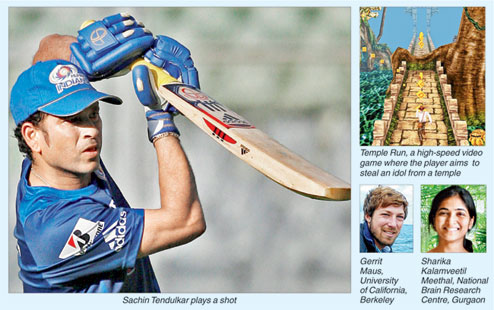 |
New Delhi, May 9: Science has provided a peek into how some batsmen hook the fiercest bouncers from some of the world’s fastest bowlers.
Neither Sharika Kalamveetil Meethal in Gurgaon nor Gerrit Maus in San Francisco has any interest in cricket, but their research may explain how cricketers tackle fast balls or kids win high-speed video games.
The two neuroscientists, in independent research pursuits on two sides of the world, have unravelled elements of key brain mechanisms that children and adults appear to use when they rapidly react to what they see with their eyes.
Maus, a post-doctoral scientist at the University of California, Berkeley, and his colleagues have identified a section of the brain that they say allows people to predict the trajectories of fast-moving objects they are trying to follow with their eyes.
Sharika, a doctoral (PhD) student at the National Brain Research Centre (NBRC), Manesar, Gurgaon, and her colleagues in Bangalore and the Netherlands have shown how the brain plans and controls sequential eye movements.
The study by Maus, published in the journal Neuron on Wednesday, has pinpointed a section of the brain’s visual cortex called V5 as the area that enables people to see moving objects in their predicted positions. The study suggests that V5 helps compensate for the brain’s relatively slow capacity to process rapidly changing visual signals — such as a 150kmph flight of a cricket ball hurled by a bowler.
“The fundamental problem is that our brains don’t work in real-time,” Maus said. The brain takes about a tenth of a second to process what the eyes see. Scientists have long suspected that fast reactions would require some kind of predictive calculations by the brain. “Without some prediction mechanism, our perception would be out of sync with the real world,” Maus told The Telegraph.
Studies in the past have tried to understand the prediction, but the Berkeley study is the first to show which area of the brain predicts the positions of objects.
In their experiments, the scientists used functional magnetic resonance imaging scans of six volunteers who watched a two-part visual illusion to determine that V5 is the region where the prediction occurs while a person watches moving objects.
Sharika, guided by Aditya Murthy at the Indian Institute of Science (IISc), Bangalore, explored a different mechanism — how the brain plans and executes sequential eye movements — and observed how past experience regulates future behaviour.
Their study has bolstered the evidence for what some scientists call a “performance monitoring system in the brain” that seems to evaluate the result of a preceding movement in a sequence before planning a subsequent movement.
“We show for the first time how the brain regulates the advance planning of a movement in a sequence in anticipation of what the task demands,” said Sharika.
Her work, part of which was done with collaborators at the Utrecht University in the Netherlands, has also shown that a region called the supplementary eye field in a zone called the medial frontal cortex of the brain plays a role in regulating such planning of sequential moves.
“This (the supplementary eye field) appears to be a critical node that helps regulate sequential movement planning and helps optimise performance,” Murthy, associate professor at the Centre for Neuroscience at the IISc, told this newspaper.
Murthy cautions that while their study exclusively examined sequential eye movements, it is reasonable to assume that this research is exploring a “generic error performance monitoring system” that may also be involved in planning arm or hand movements.
Sharika studied the sequential eye movements in volunteers who tracked a green and a red box on a computer screen. She used a technique called transcranial magnetic stimulation to show the role of the supplementary eye field in planning the sequential eye movements.
The NBRC study was recently published in the US journal Proceedings of the National Academy of Sciences.
While the Berkeley and the NBRC efforts investigated independent mechanisms, researchers suspect that both mechanisms may be involved in the eye, brain and arm coordination that is required for tasks such as striking fast balls or returning fast tennis serves. “Our study was not about the planning and execution of eye movements, but about perception of positions. But the eye movement system also needs to anticipate moving objects to be able to steer (sequential movements) to land on target,” Maus said.
“It is possible that perceptual mechanisms in the area V5 aid the eye movement system for this.”










